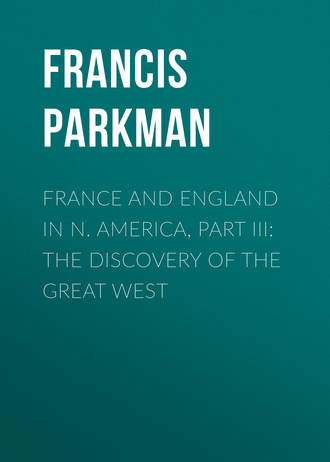 полная версия
полная версияFrance and England in N. America, Part III: The Discovery of the Great West
La Chine was the starting-point, and the combined parties, in all twenty- four men with seven canoes, embarked on the Lake of St. Louis. With them were two other canoes, bearing the party of Senecas who had wintered at La Salle's settlement, and who were now to act as guides. They fought their way upward against the perilous rapids of the St. Lawrence, then scarcely known to the voyager, threaded the romantic channels of the Thousand Islands, and issued on Lake Ontario. Thirty days of toil and exposure had told upon them so severely that not a man of the party, except the Indians, had escaped the attacks of disease in some form.
Their guides led them directly to the great village of the Senecas, near the banks of the Genesee, flattering them with the hope that they would here find other guides, to conduct them to the Ohio; and, in truth, the Senecas had among them a prisoner of one of the western tribes, who would have answered their purpose. The chiefs met in council: but La Salle had not yet mastered the language sufficiently to serve as spokesman; and a Dutch interpreter, brought by the priests, could not explain himself in French. The Jesuit Fremin was stationed at the village, and his servant came to their aid: but, as the two priests thought, wilfully misinterpreted them; and they also conceived the suspicion, perhaps uncharitable, that the Jesuits, jealous of their enterprise, had tampered with the Senecas, to thwart it. Be this as it may, the Indians proved impracticable, evaded their request for a guide, burned before their eyes the unfortunate western prisoner, and assured them that if they went to the Ohio the people of those parts would put them to death. As there were many among the Senecas who wished to kill them in revenge for the chief murdered near Montreal, and as these and others were at times in a frenzy of drunkenness with brandy brought from Albany, the position of the French was very hazardous. They remained, however, for a month; still clinging to the hope of obtaining guides. At length, an Indian from a village called Ganastogué, a kind of Iroquois colony at the head of Lake Ontario, offered to conduct them thither, assuring them that they would find what they sought. They left the Seneca town; coasted the south shore of the lake; passed the mouth of the Niagara, where they heard the distant roar of the cataract; and, five days after, reached Ganastogué. The inhabitants proved friendly, and La Salle received the welcome present of a Shawnee prisoner, who told them that the Ohio could he reached in six weeks, and that he would guide them to it. Delighted at this good fortune, they were about to set out; when they heard, to their astonishment, of the arrival of two other Frenchmen at a neighboring village. One of the strangers proved to be a man destined to hold a conspicuous place in the history of western discovery. This was Louis Joliet, a young man of about the age of La Salle. Like him, he had studied for the priesthood; but the world and the wilderness had conquered his early inclinations, and changed him to an active and adventurous fur-trader.
Talon had sent him to discover and explore the copper-mines of Lake Superior. He had failed in the attempt, and was now returning. His Indian guide, afraid of passing the Niagara portage lest he should meet enemies, had led him from Lake Erie, by way of Grand River, towards the head of Lake Ontario; and thus it was that he met La Salle and the Sulpitians.
This meeting caused a change of plan. Joliet showed the priests a map which he had made, of such parts of the Upper Lakes as he had visited, and gave them a copy of it; telling them, at the same time, of the Pottawattamies, and other tribes of that region, in grievous need of spiritual succor. The result was a determination on their part to follow the route which he suggested, notwithstanding the remonstrances of La Salle, who in vain reminded them that the Jesuits had pre-occupied the field, and would regard them as intruders. They resolved that the Pottawattamies should no longer sit in darkness; while, as for the Mississippi, it could be reached, as they conceived, with less risk by this northern route than by that of the south.
Since reaching the head of Lake Ontario, La Salle had been attacked by a violent fever, from which he was not yet recovered. He now told his two colleagues that he was in no condition to go forward, and should be forced to part with them. The staple of La Salle's character, as his life will attest, was an invincible determination of purpose, which set at naught all risks and all sufferings. He had cast himself with all his resources into this enterprise, and, while his faculties remained, he was not a man to recoil from it. On the other hand, the masculine fibre of which he was made did not always withhold him from the practice of the arts of address, and the use of what Dollier de Casson styles belles paroles. He respected the priesthood,—with the exception, it seems, of the Jesuits,– and he was under obligations to the Sulpitians of Montreal. Hence there can be no doubt that he used his illness as a pretext for escaping from their company without ungraciousness, and following his own path in his own way.
On the last day of September, the priests made an altar, supported by the paddles of the canoes laid on forked sticks. Dollier said mass; La Salle and his followers received the sacrament, as did also those of his late colleagues; and thus they parted,—the Sulpitians and their party descending the Grand River towards Lake Erie, while La Salle, as they supposed, began his return to Montreal. What course he actually took, we shall soon inquire; and meanwhile, for a few moments, we will follow the priests. When they reached Lake Erie, they saw it tossing like an angry ocean under a wild autumnal sky. They had no mind to tempt the dangerous and unknown navigation, and encamped for the winter in the forest near the peninsula called the Long Point. Here they gathered a good store of chestnuts, hickory-nuts, plums, and grapes; and built themselves a log- cabin, with a recess at the end for an altar. They passed the winter unmolested, shooting game in abundance, and saying mass three times a week. Early in spring, they planted a large cross, attached to it the arms of France, and took formal possession of the country in the name of Louis XIV. This done, they resumed their voyage, and, after many troubles, landed one evening in a state of exhaustion on or near Point Pelée, towards the western extremity of Lake Erie. A storm rose as they lay asleep, and swept off a great part of their baggage, which, in their fatigue, they had left at the edge of the water. Their altar-service was lost with the rest,—a misfortune which they ascribed to the jealousy and malice of the Devil. Debarred henceforth from saying mass, they resolved to return to Montreal and leave the Pottawattamies uninstructed. They presently entered the strait by which Lake Huron joins Lake Erie; and, landing near where Detroit now stands, found a large stone, somewhat suggestive of the human figure, which the Indians had bedaubed with paint, and which they worshipped as a manito. In view of their late misfortune, this device of the arch-enemy excited their utmost resentment. "After the loss of our altar-service," writes Galinée, "and the hunger we had suffered, there was not a man of us who was not filled with hatred against this false deity. I devoted one of my axes to breaking him in pieces; and then, having fastened our canoes side by side, we carried the largest piece to the middle of the river, and threw it, with all the rest, into the water, that he might never be heard of again."
This is the first recorded passage of white men through the Strait of Detroit; though Joliet had, no doubt, passed this way on his return from the Upper Lakes. [Footnote: The Jesuits and fur-traders, on their way to the Upper Lakes, had followed the route of the Ottawa, or, more recently, that of Toronto and the Georgian Bay. Iroquois hostility had long closed the Niagara portage and Lake Erie against them.] The two missionaries took this course, with the intention of proceeding to the Saut Sainte Marie, and there joining the Ottawas, and other tribes of that region, in their yearly descent to Montreal. They issued upon Lake Huron; followed its eastern shores till they reached the Georgian Bay, near the head of which the Jesuits had established their great mission of the Hurons, destroyed, twenty years before, by the Iroquois; [Footnote: "Jesuits in North America."] and, ignoring or slighting the labors of the rival missionaries, held their way northward along the rocky archipelago that edged those lonely coasts. They passed the Manatoulins, and, ascending the strait by which Lake Superior discharges its waters, arrived on the twenty-fifth of May at Ste. Marie du Saut. Here they found the two Jesuits, Dablon and Marquette, in a square fort of cedar pickets, built by their men within the past year, and enclosing a chapel and a house. Near by, they had cleared a large tract of land, and sown it with wheat, Indian corn, peas, and other crops. The new-comers were graciously received, and invited to vespers in the chapel; but they very soon found La Salle's prediction made good, and saw that the Jesuit fathers wanted no help from St. Sulpice. Galinée, on his part, takes occasion to remark that, though the Jesuits had baptized a few Indians at the Saut, not one of them was a good enough Christian to receive the Eucharist; and he intimates, that the case, by their own showing, was still worse at their mission of St. Esprit. The two Sulpitians did not care to prolong their stay; and, three days after their arrival, they left the Saut: not, as they expected, with the Indians, but with a French guide, furnished by the Jesuits. Ascending French River to Lake Nipissing, they crossed to the waters of the Ottawa, and descended to Montreal, which they reached on the eighteenth of June. They had made no discoveries and no converts; but Galinée, after his arrival, made the earliest map of the Upper Lakes known to exist. [Footnote: Galinée appears to have made use of the map given him by Joliet. He says, in the narrative of his journey, that he has laid down on his own map nothing but what he had himself seen; but this is disproved by the map itself. Thus, he represents with minuteness the northern coast as far west as the islands at the mouth of Green Bay; but that he never went so far is evident not only from his own journal, but from the fact that he was ignorant of the existence of the Straits of Michillimackinac and the peninsula of Michigan; Lakes Huron and Michigan being by him merged into one, under the name of "Michigané, ou Mer Douce des Hurons." The map, of which a fac-simile is before me, measures four and a half feet by three and a half. It is covered with descriptive remarks, which, oddly enough, are all inverted, so that it must be turned with the north side down in order to read them. Faillon has engraved it, but on a small scale, with the omission of most of the inscriptions, and other changes. The well- known Jesuit map of Lake Superior appeared the year after.
Besides making the map, Galinée wrote a very long and minute journal of the expedition, which is preserved in the Bibliothèque Impériale.
Much of the substance of it is given by Faillon, Colonie Française, iii. chap, vii., and Margry, Journal Général de l'Instruction Publique, xxxi. No. 67. In the letters of Talon to Colbert are various allusions to the journey of Dollier and Galinée.]
We return now to La Salle, only to find ourselves involved in mist and obscurity. What did he do after he left the two priests? Unfortunately, a definite answer is not possible; and the next two years of his life remain in some measure an enigma. That he was busied in active exploration, and that he made important discoveries, is certain; but the extent and character of these discoveries remain wrapped in doubt. He is known to have kept journals and made maps; and these were in existence, and in possession of his niece, Madeleine Cavelier, then in advanced age, as late as the year 1756; [Footnote: See Margry, in Journal Général de l'Instruction Publique, xxxi. 659.] beyond which time the most diligent inquiry has failed to trace them. The Abbé Faillon affirms, that some of La Salle's men, refusing to follow him, returned to La Chine, and that the place then received its name, in derision of the young adventurer's dream of a westward passage to China. [Footnote: Dollier de Casson alludes to this as "cette transmigration célèbre qui se fit de la Chine dans ces quartiers."] As for himself, the only distinct record of his movements is that contained in an unpublished paper, entitled, "Histoire de Monsieur de la Salle." It is an account of his explorations, and of the state of parties in Canada previous to the year 1678; taken from the lips of La Salle himself, by a person whose name does not appear, but who declares that he had ten or twelve conversations with him at Paris, whither he had come with a petition to the Court. The writer himself had never been in America, and was ignorant of its geography; hence blunders on his part might reasonably be expected. His statements, however, are in some measure intelligible; and the following is the substance of them. After leaving the priests, La Salle went to Onondaga, where we are left to infer that he succeeded better in getting a guide than he had before done among the Senecas. Thence he made his way to a point six or seven leagues distant from Lake Erie, where he reached a branch of the Ohio; and, descending it, followed the river as far as the rapids at Louisville, or, as has been maintained, beyond its confluence with the Mississippi. His men now refused to go farther, and abandoned him, escaping to the English and the Dutch; whereupon he retraced his steps alone. [Footnote: As no part of the memoir referred to has been published, I extract the passage relating to this journey. After recounting La Salle's visit with the Sulpitians to the Seneca village, and stating that the intrigues of the Jesuit missionary prevented them from obtaining a guide, it speaks of the separation of the travellers and the journey of Galinée and his party to the Saut Ste. Marie, where "les Jésuites les congédièrent." It then proceeds as follows: "Cependant Mr. de la Salle continua son chemin par une rivière qui va de l'est à l'ouest; et passe à Onontaqué (Onondaga), puis à six ou sept lieues au-dessous du Lac Erié; et estant parvenu jusqu'au 280me ou 83me degré de longitude, et jusqu'au 4lme degré de latitude, trouva un sault qui tombe vers l'ouest dans un pays has, marescageux, tout couvert de vielles souches, don't il y en a quelquesunes qui sont encore sur pied. Il fut done contraint de prendre terre, et suivant une hauteur qui le pouvoit mener loin, il trouva quelques sauvages qui luy dirent que fort loin de là le mesme fleuve qui se perdoit dans cette terre basse et vaste se réunnissoit en un lit. Il continua done son chemin, mais comme la fatigue estoit grande, 23 ou 24 hommes qu'il avoit menez jusques là le quittèrent tous en une nuit, regagnèrent le fleuve, et se sauvèrent, les uns à la Nouvelle Hollande et les autres à la Nouvelle Angleterre. Il se vit done seul a 400 lieues de chez luy, où il ne laisse pas de revenir, remontant la rivière et vivant de chasse, d'herbes, et de ce que luy donnèrent les sauvages qu'il rencontra en son chemin."] This must have been in the winter of 1669-70, or in the following spring; unless there is an error of date in the statement of Nicolas Perrot, the famous voyageur, who says that he met him in the summer of 1670, hunting on the Ottawa with a party of Iroquois. [Footnote: Perrot, Mèmoires, 119, 120.]
But how was La Salle employed in the following year? The same memoir has its solution to the problem. By this it appears that the indefatigable explorer embarked on Lake Erie, ascended the Detroit to Lake Huron, coasted the unknown shores of Michigan, passed the Straits of Michillimackinac, and leaving Green Bay behind him, entered what is described as an incomparably larger bay, but which was evidently the southern portion of Lake Michigan. Thence he crossed to a river flowing westward,—evidently the Illinois,—and followed it until it was joined by another river flowing from the northwest to the southeast. By this, the Mississippi only can be meant; and he is reported to have said that he descended it to the thirty-sixth degree of latitude; where he stopped, assured that it discharged itself not into the Gulf of California, but into the Gulf of Mexico; and resolved to follow it thither at a future day, when better provided with men and supplies. [Footnote: The memoir,– after stating, as above, that he entered Lake Huron, doubled the peninsula of Michigan, and passed La Baye des Puants (Green Bay),—says, "Il reconnut une baye incomparablement plus large; au fond de laquelle vers l'ouest il trouva un trés-beau havre et au fond de ce havre un fleuve qui va de l'est à l'ouest. Il suivit ce fleuve, et estant parvenu jusqu'environ le 280me degré de longitude et le 39me de latitude, il trouva un autre fleuve qui se joignant au premier coulait du nordouest au sud-est, et il suivit ce fleuve jusqu'au 36me degré de latitude."
The "très-beau havre" may have been the entrance of the River Chicago, whence, by an easy portage, he might have reached the Des Plaines branch of the Illinois. We shall see that he took this course in his famous exploration of 1682.
The Intendant Talon announces in his despatches of this year that he had sent La Salle southward and westward to explore.]
The first of these statements,—that relating to the Ohio,—confused, vague, and in great part incorrect as it certainly is, is nevertheless well sustained as regards one essential point. La Salle himself, in a memorial addressed to Count Frontenac in 1677, affirms that he discovered the Ohio, and descended it as far as to a fall which obstructed it. [Footnote: The following are his words (he speaks of himself in the third person): "L'année 1667, et les suivantes, il fit divers voyages avec beaucoup de dépenses, dans lesquels il découvrit le premier beaucoup de pays au sud des grands lacs, et entre autres la grande rivière d'Ohio; il la suivit jusqu'à un endroit ou elle tombe de fort haut dans de vastes marais, a la hauteur de 37 degrés, après avoir été grossie par une autre rivière fort large qui vient du nord; et toutes ces eaux se déchargent selon toutes les apparences dans le Golfe du Mexique."
This "autre riviére," which, it seems, was above the fall, may have been the Miami or the Scioto. There is but one fall on the river, that of Louisville, which is not so high as to deserve to be described as "fort haut," being only a strong rapid. The latitude, as will be seen, is different in the two accounts, and incorrect in both.] Again, his rival, Louis Joliet, whose testimony on this point cannot be suspected, made two maps of the region of the Mississippi and the Great Lakes. The Ohio is laid down on both of them, with an inscription to the effect that it had been explored by La Salle. [Footnote: One of these maps is entitled Carte de la découverte du Sieur Joliet, 1674. Over the lines representing the Ohio are the words, "Route du sieur de la Salle pour aller dans le Mexique." The other map of Joliet bears, also written over the Ohio, the words, "Rivière par où descendit le sieur de la Salle au sortir du lac Erié pour aller clans le Mexique." I have also another manuscript map, made before the voyage of Joliet and Marquette, and apparently in the year 1673, on which the Ohio is represented as far as to a point a little below Louisville, and over it is written, "Rivière Ohio, ainsy appellée par les Iroquois à cause de sa beauté, par où le sieur de la Salle est descendu." The Mississippi is not represented on this map; but—and this is very significant, as indicating the extent of La Salle's exploration of the following year—a small part of the upper Illinois is laid down.] That he discovered the Ohio may then be regarded as established. That he descended it to the Mississippi, he himself does not pretend; nor is there reason to believe that he did so.
With regard to his alleged voyage down the Illinois, the case is different. Here, he is reported to have made a statement which admits but one interpretation,—that of the discovery by him of the Mississippi prior to its discovery by Joliet and Marquette. This statement is attributed to a man not prone to vaunt his own exploits, who never proclaimed them in print, and whose testimony, even in his own case, must therefore have weight. But it comes to us through the medium of a person, strongly biased in favor of La Salle and against Marquette and the Jesuits.
Seven years had passed since the alleged discovery, and La Salle had not before laid claim to it; although it was matter of notoriety that during five years it had been claimed by Joliet, and that his claim was generally admitted. The correspondence of the Governor and the Intendant is silent as to La Salle's having penetrated to the Mississippi; though the attempt was made under the auspices of the latter, as his own letters declare; while both had the discovery of the great river earnestly at heart. The governor, Frontenac, La Salle's ardent supporter and ally, believed in 1672, as his letters show, that the Mississippi flowed into the Gulf of California, and, two years later, he announces to the minister Colbert its discovery by Joliet. [Footnote: Lettre de Frontenac au Ministre, 14 Nov. 1674. He here speaks of "la grande rivière qu'il (Joliet) a trouvée, qui va du nord au sud, et qui est aussi large que celle du Saint- Laurent vis-à-vis de Québec." Four years later, Frontenac speaks slightingly of Joliet, but neither denies his discovery of the Mississippi nor claims it for La Salle, in whose interest he writes.] After La Salle's death, his brother, his nephew, and his niece addressed a memorial to the King, petitioning for certain grants in consideration of the discoveries of their relative, which they specify at some length; but they do not pretend that he reached the Mississippi before his expeditions of 1679 to 1682. [Footnote: Papiers de Famille, MSS.; Mémoire présenté au Roi. The following is an extract: "Il parvient … jusqu'à la rivière des Illinois. Il y construisit un fort situé à 350 lieues au-delà du fort de Frontenac, et suivant ensuite le cours de cette rivière, il trouve qu'elle se jettoit dans un grand fleuve appellé par ceux du pays Missisippi, c'est à dire grande eau, environ cent lieues audessous du fort qu'il venoit de construire." This fort was Fort Crêvecoeur, built in 1680, near the site of Peoria. The memoir goes on to relate the descent of La Salle to the Gulf, which concluded this expedition of 1679-82.] This silence is the more significant, as it is this very niece who had possession of the papers in which La Salle recounts the journeys of which the issues are in question. [Footnote: The following is an extract, given by Margry, from a letter of the aged Madeleine Cavelier, dated 21 Février, 1756, and addressed to her nephew M. Le Baillif, who had applied for the papers in behalf of the minister, Silhouette: "J'ay cherché une occasion sûre pour vous anvoyé les papiers de M. de la Salle. Il y a des cartes que j'ay jointe à ces papiers, qui doivent prouver que, en 1675, M. de Lasalle avet déja fet deux voyages en ces decouverte, puisqu'il y avet une carte, que je vous envoye, par laquelle il est fait mention de l'androit auquel M. de Lasalle aborda près le fleuve de Mississipi." This, though brought forward to support the claim of discovery prior to Joliet, seems to indicate that La Salle had not reached the Mississippi, but only approached it, previous to 1675.
Margry, in a series of papers in the Journal Général de l'Instruction Publique for 1862, first took the position that La Salle reached the Mississippi in 1670 and 1671, and has brought forward in defence of it all the documents which his unwearied research enabled him to discover. Father Tailhan, S.J., has replied at length, in the copious notes to his edition of Nicolas Perrot, but without having seen the principal document cited by Margry, and of which extracts have been given in the notes to this chapter.] Had they led him to the Mississippi, it is reasonably certain that she would have made it known in her memorial. La Salle discovered the Ohio, and in all probability the Illinois also; but that he discovered the Mississippi has not been proved, nor, in the light of the evidence we have, is it likely.







